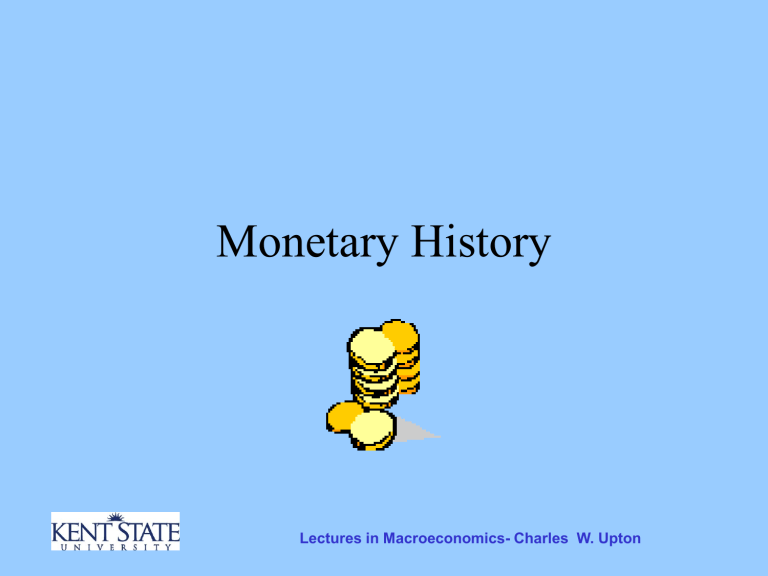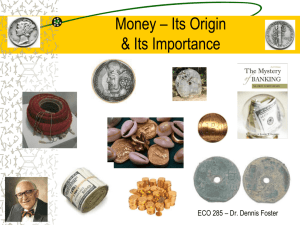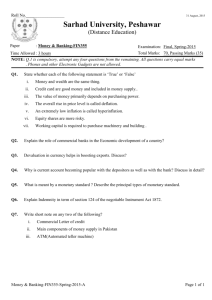PP - Personal.kent.edu

Monetary History
Lectures in Macroeconomics- Charles W. Upton
Forms that Money has Taken
• Gold
Monetary History
Forms that Money has Taken
• Gold
– How could you be sure that the piece of yellow metal was actually gold, of the right purity, and of the right amount?
Monetary History
Forms that Money has Taken
• Gold
– How could you be sure that the piece of yellow metal was actually gold, of the right purity, and of the right amount?
– Governments minted gold into coins then returned to the owner of the gold (less a service charge).
Monetary History
Forms that Money has Taken
• Gold
– How could you be sure that the piece of yellow metal was actually gold, of the right purity, and of the right amount?
– Governments minted gold into coins then returned to the owner of the gold (less a service charge).
– The government milled the edges of the coins to prevent clipping.
Monetary History
Commodity Money
• Gold
• Silver
• Wampum
• Tobacco
Monetary History
• Gold
• Silver
• Wampum
• Tobacco
Commodity Money
Many commodity moneys such as wampum and tobacco had real problems of substitutability. While an ounce of gold is identical to another ounce, the same cannot be said for wampum or
Monetary History tobacco.
Cigarettes
• World War II POW Camp
• Prisoners used cigarettes to pay other prisoners for services (washing clothes, repairing shoes, etc.)
• Bouts of Inflation and Deflation as Red
Cross Parcels arrived and the money went up in smoke.
Monetary History
Paper Money
• Continental Currency used to finance
Revolutionary War
• Between 1789 and 1865 over 30,000 different types of paper bills were issued by
1600 banks in 34 different states.
Monetary History
Paper Money
• In 1861, the US government issued greenbacks, the first national paper money to finance the War Between the States.
• The value of greenbacks (in terms of Gold) rose and fell with the fortunes of the Union
Army during the War Between the States.
Monetary History
Paper Money
• The
National Banking Act of 1863 gave the federal government permanent authority to issue money.
• Many banks issued these notes themselves, and the consequence was continued uncertainty about the value of money.
Monetary History
The 1876 Specie Act
• In 1876, the Federal Government guaranteed the convertibility of greenbacks into Gold at $20.67 an ounce.
• Paper money became commodity backed money.
Monetary History
The 1876 Specie Act
• In 1876, the Federal Government guaranteed the convertibility of greenbacks
$20.67 in paper money for one ounce of gold.
Monetary History
The Gold Standard
• From 1876 to 1933, we were on the gold standard. We converted dollars to gold and vice versa at $20.67 an ounce.
• So too were most European nations. Hence, the exchange rate between dollars and
European currencies was fixed.
• 1£ = $4.80
Monetary History
The Gold Standard
• In 1933 FDR ended the convertibility of dollars to gold at $20.67 an ounce, resetting the rate at $35 an ounce but only for government to government swaps.
• We effectively went off the gold standard.
Monetary History
The Gold Standard
• To be sure, we own a lot of gold, stored in
Fort Knox and the basement of the Federal
Reserve System in New York.
• Many people still think gold pays a role in our monetary system.
• The next slide provides a definitive list of all the roles gold plays in our monetary system.
Monetary History
Monetary History
End
©2005 Charles W. Upton.
All rights reserved
Monetary History







